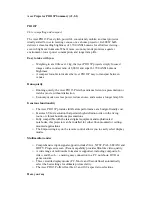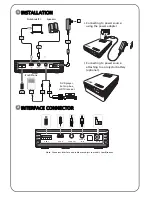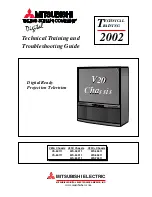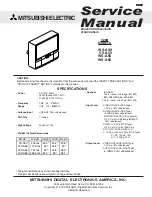
3-16
CP2000-SB User Manual
020-100162-06 Rev. 1 (03-2014)
Section 1: Introduction
*
Can also be set to trigger a full-screen flashing red alarm window on the TPC. Note that if a DMD
temperature exceeds a certain factory-set threshold for at least 2 seconds, the lamp will automatically shut
down. Recovery requires that the DMD temperature fall to a safe factory-set threshold.
†
Safety interlock.
3.5.3 TPC Alarm Window
In addition to the status bar at the bottom of any TPC screen, a full-screen red alarm window flashes if one of
the alarm conditions shown in the left column of
Table 3.2
is encountered. If a safety interlock fails, power will
no longer reach the lamp (DC output is stopped), and the lamp button on the TPC
Main
menu will be disabled.
NOTES
:
1)
A failed safety interlock automatically prevents power from going to the lamp and disables the
lamp button on the TPC Main menu. Since most interlock alarm conditions are triggered by switches, regularly
check the operation of these switch levers.
2)
With interlock integrity restored, the lamp button on the TPC
Main menu is automatically re-enabled.
Can Alarm Conditions Be Ignored?
Note every alarm window indicates a
new
condition. In a given session, the alarm window will not reappear for
a condition that you have acknowledged (shunted) but not yet solved. However, if you cycle the projector OFF
and ON again, any persisting alarm condition will trigger the alarm window again. Although it is highly
recommended that the monitored over-temperature and fan speed conditions always be set to trigger a flashing
alarm window (default), this trigger can be turned off if desired by clearing the appropriate
Alarm Triggers
checkbox in the
Advanced
menu. Once cleared, such conditions will only trigger the yellow or red Status
warning button rather than a flashing alarm window. This can be helpful in rare cases where the alarm window
is erroneously/repeatedly triggered with no detectable error condition. Disabling alarm triggers is
not
recommended for normal operation. Failed interlocks, an SSM communication fault, I
2
C fault, and lamp
failures always produce an alarm window-i.e., these alarm triggers cannot be disabled or hidden.
Other
System Supervisor Module
Detected/Not Detected
Self Test
OK/Failed
Ballast Communications
OK/Failed
Figure 3-7 Flashing Alarm Window
Blinking Red = New
Alarm Condition.
Select to “shunt” (disable) this alarm
• Condition will persist until rectified, but will not trigger another alarm window.
• Acknowledgements are discarded upon on next TPC power-up - alarm window will re-appear.
Identifies the
new alarm
condition.
Summary of Contents for CP2000-SB
Page 1: ...CP2000 SB U S E R M A N U A L 020 100162 06 ...
Page 9: ......
Page 15: ...1 6 CP2000 SB User Manual 020 100162 06 Rev 1 03 2014 Section 1 Introduction ...
Page 155: ...8 8 CP2000 SB User Manual 020 100162 06 Rev 1 03 2014 Section 1 Introduction ...
Page 157: ...8 10 CP2000 SB User Manual 020 100162 06 Rev 1 03 2014 Section 1 Introduction ...
Page 173: ...A 16 CP2000 SB User Manual 020 100162 06 Rev 1 03 2014 Section 1 Introduction ...
Page 197: ...B 24 CP2000 SB User Manual 020 100162 06 Rev 1 03 2014 Section 1 Introduction ...
















































